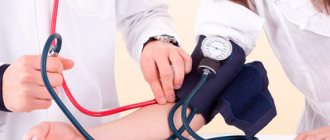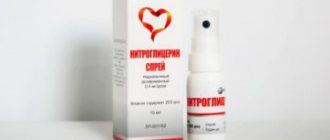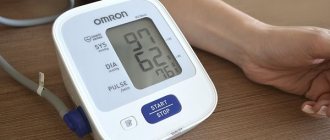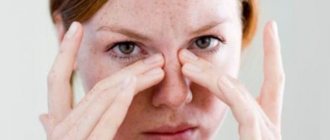Today we will talk about how to correctly measure blood pressure. And our expert will help us with this - Head of the Laboratory of Cardiovascular Aging of the Russian Gerontological Research and Clinical Center, Head of the Department of Cardiology and Personalized Medicine of the Faculty of Advanced Training of Medical Workers of the Peoples' Friendship University of Russia, Doctor of Medical Sciences, Professor Yulia Kotovskaya.
By the way, in the doctor's office the pressure can increase by about 20 mmHg. This phenomenon is called “white coat syndrome” and is associated with the excitement and anxiety that patients involuntarily experience when visiting medical institutions. Therefore, home pressure data are of particular interest to the doctor. For those who suffer from pressure surges, there is probably no need to explain the importance of regularly measuring it. Today, every hypertensive person has a tonometer in their home. But in order for his testimony to correspond to reality, it is important to follow a number of important rules. You need to measure pressure:
Regularly
As a rule, in the morning (before taking blood pressure medications) and in the evening before going to bed. But there are situations when you need to measure pressure more often. For example, if an elderly person feels dizzy when standing up. In this case, it is important to understand whether this dizziness is associated with a rise in blood pressure or not.
An important nuance . Sometimes you need to measure your blood pressure after eating. Especially if an elderly person suffers from postprandial hypotension - an asymptomatic decrease in blood pressure after eating. In some cases, it can cause fainting and falls, which can result in a fracture.
If necessary, you can increase the number of measurements yourself (for example, if you feel unwell, after physical or emotional stress).
Monitor blood pressure. Why do hypertensive patients need to keep a diary? Read more
How to measure blood pressure correctly
High blood pressure is often the cause of a heart attack or stroke, because people are often negligent about their health. Most people have no idea that their blood pressure is higher than normal. You shouldn’t go to the other extreme - immediately take pills after the first elevated tonometer readings.
The main indicator of the successful functioning of the cardiac and vascular systems is a normal level of pressure. Blood pressure levels are generally stable in healthy people. But throughout the day in ordinary life, under the influence of many factors, physical and nervous stress, shocks, stress and other phenomena, pressure can fluctuate.
Today it is not necessary to run to the doctor to get data on your blood pressure levels. Blood pressure can be monitored in a person’s usual home environment. To do this you need to have a good blood pressure monitor. Measuring blood pressure over several days will allow you to more accurately determine your blood pressure level.
Several times in a row
The pressure is constantly changing. The first measurement is usually higher than the subsequent ones, so it is recommended to take three measurements one minute apart. In this case, the first measurement is not taken into account, and the average value is estimated for the second and third. If the differences between measurements are very significant (>15 mmHg), two more measurements should be taken after 2-3 minutes and the average value should be estimated.
An important nuance . If, in addition to hypertension, an elderly person has atrial fibrillation (atrial fibrillation), then it is better to immediately take not three, but five measurements and calculate the average of the last four measurements.
Article on the topic
Hypertension, don't push! Features of high blood pressure treatment
When is it necessary to control blood pressure?
How to measure blood pressure correctly for the first time and get the most accurate result, how many times a day should the manipulation be performed? A one-time check is not enough. To make an accurate diagnosis, it is necessary to measure blood pressure twice a day for a week. Each measurement is repeated after a few minutes. The indicators should be recorded, then the average is calculated without taking into account the first day.
When is the best time to perform the procedure? Typically, blood pressure is measured immediately after waking up, you can do this while lying in bed, and the pressure is measured a second time in the evening. In case of nervous tension or a stressful situation, the procedure should be postponed. Before your next visit to the doctor, measurements should be repeated for three days.
For patients with an established diagnosis and prescribed treatment, blood pressure can be measured once a day.
For patients who periodically experience blood pressure surges, it is recommended to measure it 1-2 times a week, as well as in case of poor health, physical and emotional stress. When selecting individual antihypertensive drugs, it is necessary to measure indicators over a long period of time and record them in order to see the effect of the medications taken.
With the cuff applied correctly
The cuff must be placed on the bare shoulder. Typically, there is a mark on the cuff that should be located above the cubital fossa. The edge of the cuff should be 2 cm above the cubital fossa.
An important nuance . The size of the cuff should correspond to the circumference of the shoulder. The cuff should not be applied too tightly or, on the contrary, loosely, but so that the tip of the index finger passes under it.
Strike the right tone. How to measure blood pressure Read more
In a certain position
It is preferable to measure blood pressure while sitting. However, if a person cannot sit down, you can measure his blood pressure while lying down. If the pressure is measured while sitting, then the back should rest on the back of the chair, the legs should not be crossed, they should rest on the floor. In this case, the forearm of the hand on which the measurement is being taken should rest completely on the surface of the table so that the middle of the cuff is at the level of the heart.
If the pressure is measured in a lying position, make sure that the shoulder of the arm on which the cuff is applied is horizontal, at the level of the heart.
An important nuance . Compare the pressure levels obtained in one position, and be sure to note in a pressure diary, which you should definitely keep, in which position this or that measurement was performed. The measurement is always performed on the same hand.
Read the continuation of this topic in the next issues of our newspaper.
Which wrist tonometer is better: features and selection criteria
Operating principle, pros and cons
Have you been struggling with HYPERTENSION for many years without success?
Head of the Institute: “You will be amazed at how easy it is to cure hypertension by taking it every day...
Read more "
Compared to the classic device, which is mounted on the shoulder and has a built-in stethoscope, the wrist tonometer has a more compact size. In addition to the fact that such a meter performs its main function - it determines blood pressure, and with its help you can determine the pulse rate.
Pros of a wrist tonometer:
- Portability. The meter, which is only slightly larger in size than a wrist watch, can be easily carried with you and used on the road.
- Accuracy of indicators.
- The ability to compare data and determine the dynamics of changes.
Disadvantages of a wrist tonometer:
- Cuff length. The bracelet of the device, as a rule, has a length not exceeding 21 cm. Therefore, it is quite difficult for overweight people, children or those with very wide wrists to use such a meter.
- Age limit. Since the walls of the blood vessels located in the wrist area become less elastic with age, a tonometer on the wrist is not particularly suitable for older people - the measurement accuracy will be low.
What to look for and how to choose
In order not to be mistaken in choosing an electronic or manual wrist blood pressure monitor and to determine which model is best for you, you should pay attention to the following:
- Focus and functionality. For older people, pregnant women, children or athletes, they differ in their range of functions.
- Guarantee period. Any device has its own warranty period, but for manufacturers of higher quality models it is no less, and sometimes even more than 5 years. If the warranty period specified by the manufacturer is 1-2 years or less, then you should refuse such a purchase.
- Cuff length. If you have a non-standard wrist width, then this fact should be taken into account first.
- Measurement error. Available for every meter. Its value is indicated in the description or passport of the device.
- Price. It depends largely on what additional functions the meter has. If you only need it to periodically monitor indicators, then you can abandon unnecessary “bells and whistles” and choose an inexpensive device.
Possible additional functions
Important features that may be found in wrist pressure monitors include the following:
- Combination of automatic and mechanical operating principles. Some budget models have the ability to independently adjust pressure levels.
- Number of cells in memory. This function is responsible for the device's ability to remember measurement data. The larger the memory capacity, the easier it will be to track the dynamics of changes in indicators.
This function is indispensable for those who suffer from cardiovascular diseases.
- Intelligent assistants and systems. It is sometimes difficult for older people to learn how to use various equipment. To avoid complications, some models can be configured with voice assistance.
- Availability of clock, alarm clock, calendar. Not always necessary and important functions, but for those who, due to circumstances, must constantly monitor their pulse and are also away from home, they can come in handy.
- Indicators. Indicators of arrhythmia, correct hand position during measurements, motion sensors - all this is responsible for the accuracy of the data. If you do something wrong when taking readings, you will be immediately notified about this by a special signal.
How to use correctly: instructions for use
How to correctly measure blood pressure with a portable tonometer on the wrist? The usage algorithm is simple and is as follows:
- You need to remove the device from the packaging and turn it on.
- Place it on the wrist of your left hand, tighten the cuff tightly so that it is tightly pressed to the wrist and does not twist. It is more convenient to measure pressure by turning the display towards the inside of your arm.
- Place your bent left hand to the middle of your chest (where your heart is).
- Wait a while. As a rule, many models give a sound signal that measurements have been taken and recorded. The waiting time is usually no more than 30 seconds.
- Record the readings and remove the cuff.
What do doctors say about wrist blood pressure monitors? Watch the video:
Review of the best models
OMRON R5 Prestige
Not the most budget model, but it has many additional functions. It is fully automatic and has a memory of up to 180 measurements. Standard length cuff – up to 21.5 cm.
Why do you feed pharmacies if hypertension is afraid of the usual like fire...
Tabakov has revealed a unique remedy against hypertension! To reduce blood pressure while preserving blood vessels, add to…
It determines the accuracy of measurements, and if an error occurs during the measurement process, the meter will independently cancel all indicators and will take measurements until the result is accurate and stable.
The average price in Russia is from 5,700 to 6,900 rubles.
AND UB-202
It belongs to the devices of the middle price category; among the additional functions it has is the presence of a WHO scale and an arrhythmia indicator. This wrist automatic blood pressure monitor has a memory of up to 90 measurements.
The standard cuff length is up to 21.5 cm. Compared to other models, it is one of the lightest - 102 g. The manufacturer positions its product as mobile and compact, suitable for young people who lead an active image.
The average price in Russia is from 2300 to 3500 rubles.
NISSEI WS-1000
It is semi-automatic, that is, the pressure indicator in the cuff is adjusted manually. Such a device is budgetary and has no additional functions other than simultaneous indication of arterial parameters and pulse.
Capable of storing up to 30 measurements. The standard cuff length is up to 21.5 cm, but its minimum value, unlike other models, is 12.5 cm. The device can also be used by teenagers. Operates only on batteries.
The average price in Russia is from 1500 to 2200 rubles.
Average prices, frequently asked questions and answers
- When is the best time to take readings with a wrist tonometer?
Blood pressure should be measured in a comfortable environment, 1-2 hours after eating, drinking alcohol or smoking. The cuff should be placed on the left arm. - Which is better to choose a wrist blood pressure monitor: semi-automatic or automatic?
There is no fundamental difference, but if maximum simplicity and speed of measurements are important to you, then choose automatic. - What is the advantage of such a wrist device compared to the same mechanical shoulder device?
It is not always convenient to use a mechanical device yourself, because only a doctor can accurately take readings. In addition, it is not suitable for people with poor hearing. This meter is small in size and much easier to use: it will do everything for you.
To summarize the above, we can say that a wrist tonometer is a very useful and necessary thing. If you are not one of those who cannot use such a device due to age or certain physical characteristics, then you can safely purchase it - it certainly will not lie idle.











